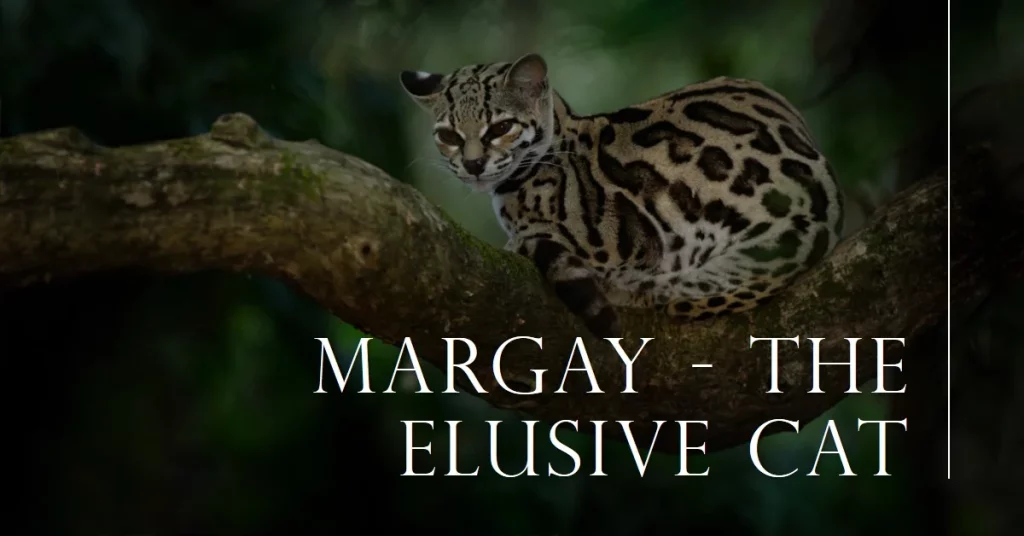Difference Between Ocelot and Margay
Did you know what is differences between the Ocelot and Margay. Both species are small wild cats, native to the Americas. These wild cats, native to the dense jungles of Central and South America, possess a certain allure that beckons animal enthusiasts and researchers alike.
They look like same they are different.
Physical Appearance

Ocelot: The Ocelot has gray to golden brown fur with a pattern of brown spots and patches bordered in black on its sides. These spots come in various patterns like rosettes, slashes, speckles, and bars. A typical Ocelot has two to three stripes on its cheeks and four to five horizontal stripes on its neck and chest. The distinguishing feature of an Ocelot is its thinner, shorter tail, shorter than or equal to the length of its hind legs.

Margay: Slightly smaller in size, the Margay stands about two feet tall from feet to shoulders, measuring three feet in length, and weighs between five to twelve pounds. It also has gray to golden-brown fur with black and brown spots and patterns, resembling the Ocelot.The Margay has a shorter head, larger eyes, and a distinctly longer tail in relation to its body size as compared to the Ocelot.
Habitat, Range, and Distribution
Ocelot: Ocelots are found in the rainforests of Central and South America. The Ocelot depends on dense vegetation for protection, denning, and hunting purposes.
Margay: Margays are almost exclusively found in forest habitats that range from humid tropical evergreen and deciduous forests to montane and cloud forests, continuous stretches of woodland to small swamp fragments surrounded by savanna, and even coffee and cocoa plantations.
Behavior
Ocelot: Nocturnal in nature, Ocelots spend their days hiding and nights hunting and playing. Armed with retractable claws, they are well-equipped for seizing and holding prey.
Margay: The Margay, known for its extraordinary acrobatic skills and preference for heights, does most of its hunting above ground.This creature hunt and eats species like rodents, birds, and insects and also eat fruit. They mostly hunt at night.
Dietary Preferences
Ocelot: Possessing varied dietary preferences, Ocelots hunt both terrestrial and arboreal prey, which include small mammals, birds, reptiles, and even fish.
Margay: Margays have a more specialized diet, focusing mainly on arboreal animals like tree-dwelling rodents, birds, and insects, as well as fruit.
Mating Habits
Ocelot: The Ocelot’s mating habits are less specific, with breeding occurring throughout the year. However, it heavily depends on the food availability in their region.
Margay: Margays, similar to Ocelots, also breed throughout the year. However, their breeding habits are less studied in comparison.
Differences Table

Here is a table of the differences between ocelots and margays:
| Feature | Ocelot | Margay |
|---|---|---|
| Size | Larger (40-50 inches long, 20-30 pounds) | Smaller (30-40 inches long, 10-20 pounds) |
| Head | Longer, with more pronounced snout | Shorter and rounder |
| Eyes | Larger | Smaller and more almond-shaped |
| Ears | Smaller | Larger and more pointed |
| Tail | Shorter | Longer and bushy |
| Habitat | Found in a variety of habitats, including forests, grasslands, and swamps | Found primarily in forests |
| Diet | Consists of small mammals, birds, reptiles, and fish | Consists of similar prey, but also includes insects |
| Reproduction | Mates in the spring and summer; female gives birth to a litter of 2-4 kittens after a gestation period of about 80 days | Mates in the spring and summer; female gives birth to a litter of 1-3 kittens after a gestation period of about 70 days |
| Conservation status | Listed as “Least Concern” on the IUCN Red List | Listed as “Near Threatened” on the IUCN Red List |
| Behavior | Solitary animals; active during the day and night; excellent climbers and swimmers | Solitary animals; active during the day and night; excellent climbers and swimmers |
| Threats | Habitat loss and hunting | Habitat loss and hunting |
In conclusion, while Ocelots and Margays may appear similar, they have noteworthy differences in their physical features, habitat, diet, and behavior.
Ocelots have thinner and shorter tails, prefer diverse habitats, and have a broader diet spectrum.
In contrast, Margays have longer
Refence Link







